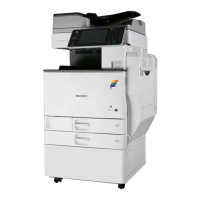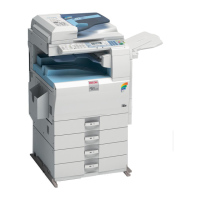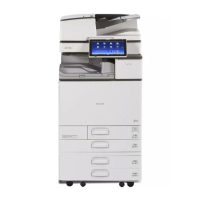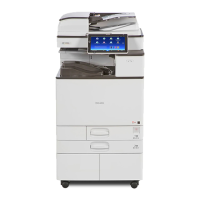20 June 2005 SERVICE PROGRAM MODE TABLES
5-15
Service
Tables
2969*
LD – PWM Selection
Printer Output LD – PWM Selection [1 ~ 4 / 1 / 1 step]
2969 1*
Changes the LD power PWM control for printed copies. A smaller value produces
a lighter image. Use this SP to adjust the image density for printing from a
personal computer or printing a received fax message.
1: 87.5% 2: 75% 3: 62.5% 4: 50%
Fax Output LD – PWM Selection [1 ~ 4 / 1 / 1 step]
2969 2*
Changes the LD power PWM control for printed fax messages. A smaller value
produces a lighter image. Use this SP to adjust the image density for printing fax
messages.
1: 87.5% 2: 75% 3: 62.5% 4: 50%
2971
Toner Full Sensor Count
DFU
Grayscale Limit
2972*
A new feature of this machine that controls the halftone density level to prevent
deterioration of the OPC. The halftone density is detected by the ID sensor, and
the machine adjusts the intensity of the LD beam according to the upper/lower
limit setting.
Upper Limit [0 ~ 100 / 60 / 1 step]
2972 1*
Defines the upper limit for grayscale.
A larger value allows a wider range of halftones at the pale end of the scale. If the
image contains pale areas with fuzzy borders surrounded by dark areas, reduce
this value to make the borders clearer.
Lower Limit [0 ~ 100 / 40 / 1 step]
2972 2*
Defines the lower limit for grayscale.
A smaller value allows a wider range of halftones at the dark end of the scale.
Grayscale Copy Interval Check [0 ~ 1000 / 100 / 10 step]
2973*
Sets the halftone operation interval in order to prevent deterioration of the OPC. If
the number of copies exceeds this setting, at the end of the job, or if the door is
opened and closed, charge correction is executed.
Image Density Adjustment [1 ~ 5 / 3 / 1 step]
2974*
Adjusts image density. Changing this setting adjusts development bias and ID
sensor output voltage that in turn raises or lowers image density.
Toner End Detection ON
Time
[0 ~ 2,000 / 0 / 10 s step] 2975*
Sets a time limit for issuing the toner near end warning on the operation panel.
The time may need to be shorter for customers who run especially large print jobs
(working at night, for example) to ensure earlier warning of the toner near end
condition so toner out does not interrupt a long job.
0: Normal end detection (90 sheets after near-end detected (SP2213)

